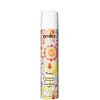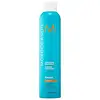What's inside
What's inside
 Key Ingredients
Key Ingredients

No key ingredients
 Benefits
Benefits

 Concerns
Concerns

 Ingredients Side-by-side
Ingredients Side-by-side

Hydrofluorocarbon 152a
Alcohol Denat.
AntimicrobialButyl Ester Of Pvm/Ma Copolymer
Octylacrylamide/Acrylates/Butylaminoethyl Methacrylate Copolymer
Water
Skin ConditioningEthyl Ester Of Pvm/Ma Copolymer
Aminomethyl Propanol
BufferingParfum
MaskingLactamide Mea
HumectantHippophae Rhamnoides Fruit/Seed Oil
AntimicrobialGlycerin
HumectantTocopheryl Acetate
AntioxidantN-Butyl Alcohol
PerfumingPPG-12 Dimethicone
Skin ConditioningBenzyl Benzoate
AntimicrobialHydroxycitronellal
PerfumingLimonene
PerfumingCitronellol
PerfumingCoumarin
PerfumingHydrofluorocarbon 152a, Alcohol Denat., Butyl Ester Of Pvm/Ma Copolymer, Octylacrylamide/Acrylates/Butylaminoethyl Methacrylate Copolymer, Water, Ethyl Ester Of Pvm/Ma Copolymer, Aminomethyl Propanol, Parfum, Lactamide Mea, Hippophae Rhamnoides Fruit/Seed Oil, Glycerin, Tocopheryl Acetate, N-Butyl Alcohol, PPG-12 Dimethicone, Benzyl Benzoate, Hydroxycitronellal, Limonene, Citronellol, Coumarin
 Reviews
Reviews

Ingredients Explained
These ingredients are found in both products.
Ingredients higher up in an ingredient list are typically present in a larger amount.
Aminomethyl Propanol is used to adjust the pH of products. It is also used as a base to create other organic compounds. Having a balanced pH is important for protecting your skin.
Aminomethyl propanol is safe to use in cosmetics up to 1%. It is soluble in water.
We don't have a description for Hydrofluorocarbon 152a yet.
We don't have a description for Octylacrylamide/Acrylates/Butylaminoethyl Methacrylate Copolymer yet.
Parfum is a catch-all term for an ingredient or more that is used to give a scent to products.
Also called "fragrance", this ingredient can be a blend of hundreds of chemicals or plant oils. This means every product with "fragrance" or "parfum" in the ingredients list is a different mixture.
For instance, Habanolide is a proprietary trade name for a specific aroma chemical. When used as a fragrance ingredient in cosmetics, most aroma chemicals fall under the broad labeling category of “FRAGRANCE” or “PARFUM” according to EU and US regulations.
The term 'parfum' or 'fragrance' is not regulated in many countries. In many cases, it is up to the brand to define this term.
For instance, many brands choose to label themselves as "fragrance-free" because they are not using synthetic fragrances. However, their products may still contain ingredients such as essential oils that are considered a fragrance by INCI standards.
One example is Calendula flower extract. Calendula is an essential oil that still imparts a scent or 'fragrance'.
Depending on the blend, the ingredients in the mixture can cause allergies and sensitivities on the skin. Some ingredients that are known EU allergens include linalool and citronellol.
Parfum can also be used to mask or cover an unpleasant scent.
The bottom line is: not all fragrances/parfum/ingredients are created equally. If you are worried about fragrances, we recommend taking a closer look at an ingredient. And of course, we always recommend speaking with a professional.
Learn more about Parfum